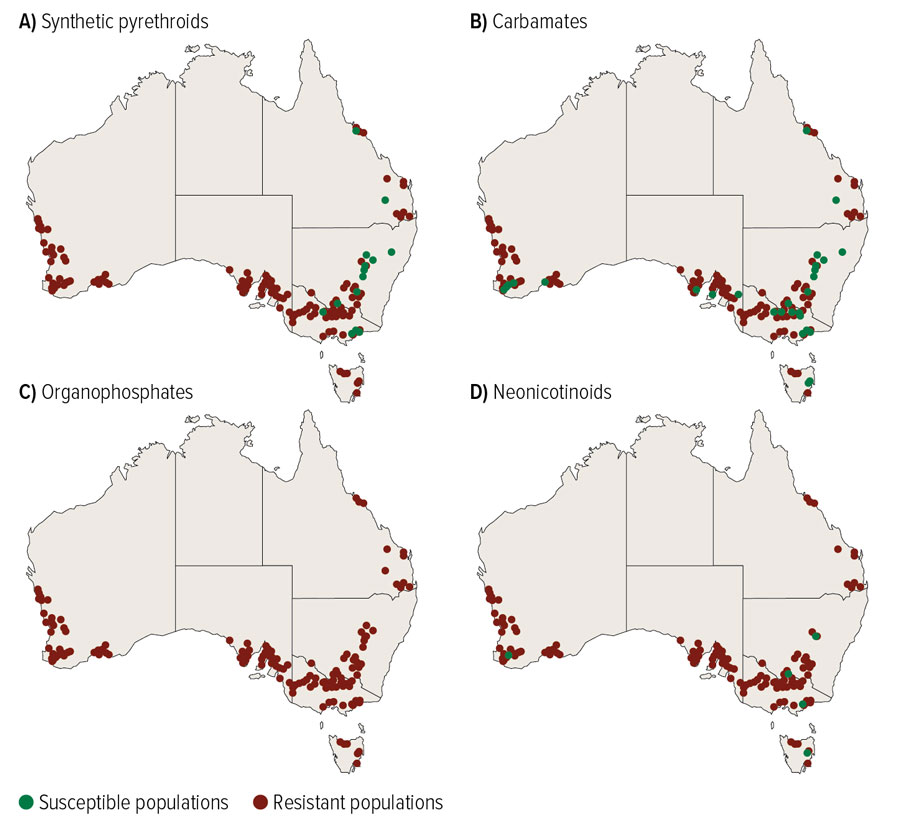Key points
- Green peach aphid (GPA) damages crops by direct feeding and as a virus carrier
- GPA is evolving resistance to many insecticides
- Through genetic profiling, an aphid clones database allows researchers to identify a population's likely resistance status by identifying the aphids’ genetic lineage
The green peach aphid (Myzus persicae – GPA) is a major pest of many crops, with canola being particularly susceptible. In addition to feeding damage, the species is a carrier of more than 100 plant viruses–such as Turnip yellows virus (formerly known as Beet western yellows virus). It poses a serious management challenge as it evolves resistance to insecticides.
Insecticide resistance testing
Previous research has identified resistance in Australian GPA populations to four out of the five chemical groups registered for use on canola. GRDC-invested research with cesar and CSIRO, which ran from 2015 to 2019, tested for resistance in specimens collected from more than 450 GPA populations.
The majority were found to have high resistance to synthetic pyrethroids and carbamates, as well as low-level resistance to neonicotinoids and organophosphates (Figure 1). High selection pressure, due to widespread use of neonicotinoid seed treatments in canola, poses a risk of further resistance evolving to this chemical.
Testing for resistance to sulfoxaflor following reported control failures in the Esperance region of WA also identified GPA populations with reduced sensitivity to this insecticide. These findings show the need for industry-wide adoption of resistance management strategies.
Figure 1: Maps indicating resistance status of tested populations tested for synthetic pyrethroids, carbamates, organophosphates and neonicotinoids. The red dots represent resistant populations while the green dots represent susceptible populations.

Source: cesar
Genetic profiling
GPA in Australia tend to reproduce asexually (giving birth to ‘genetic clones’). This means that aphids generally have low genetic variation within populations.
Research was undertaken to analyse the different genetic profiles of GPA and associated mutations that confer resistance. These profiles now form a searchable database for known clones that allow researchers to identify the likely resistance status of a population by identifying the aphids’ genetic lineage.
Management of a sticky trap network and subsequent genetic testing also allowed screening for the mutation ‘R81T’. This is found in GPA populations overseas and confers near total resistance to neonicotinoids. Fortunately, this mutation was not identified in any of the aphids tested in Australia. However, there is a risk of this mutation becoming present in Australia either through local resistance evolution or introduction from abroad. This highlights the importance of remaining vigilant in identifying and tracking harmful genetic mutations.
New resources
Resources are available to help manage this aphid to reduce the risk of control failures and the evolution of resistance.
The Green Peach Aphid Best Management Practice Guide – Southern provides an overview of GPA management, with a new resistance management strategy to begin in 2021. This will be undertaken as part of a new GRDC investment. This new project will look to address knowledge gaps regarding virus risks, dispersal patterns of aphids and baseline sensitivity of soon-to-be registered chemicals.
More information or free resistance testing: Associate Professor Paul Umina, 03 9349 4723, pumina@cesaraustralia.com

























































